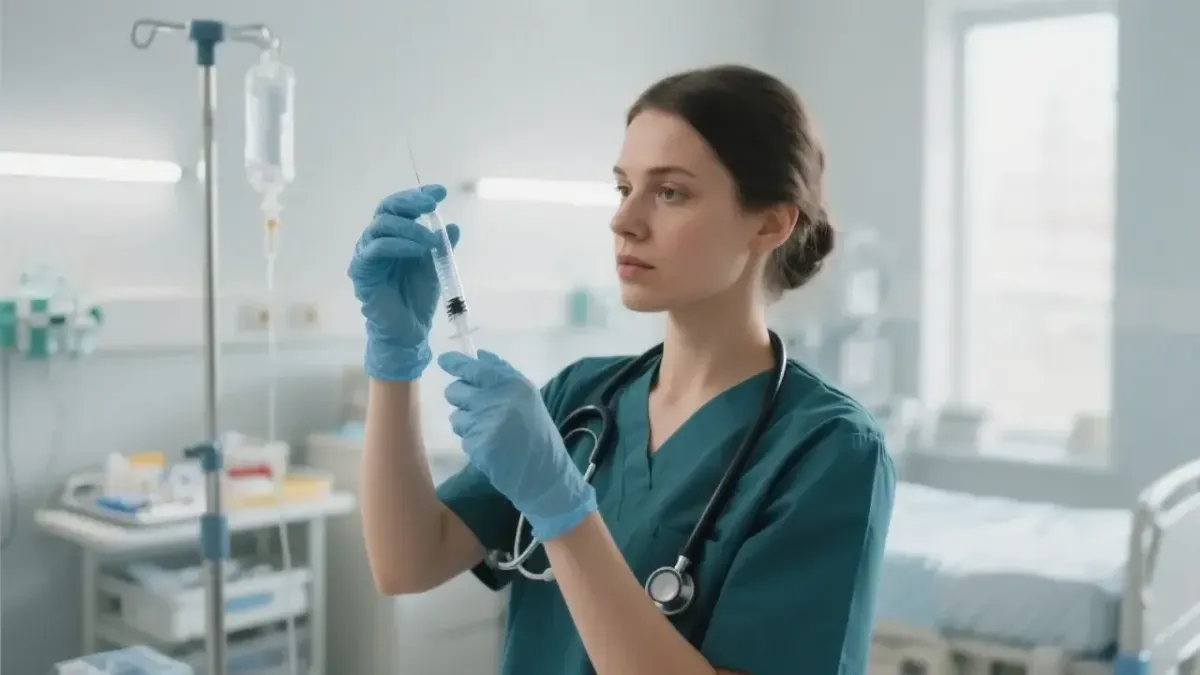The Hidden Danger in a Plastic Syringe: A Top Patient Safety Concern for 2024
Date published: July 17, 2025

A 3-year-old is discharged with pain medication. The caregiver, handed an oral liquid in a parenteral syringe, assumes it’s safe. Later that night, the child aspirates during administration and is rushed to the ER, fighting to breathe.
This isn't a hypothetical. This is how patients get hurt.
In fact, the misuse of parenteral syringes to administer oral liquid medications is so prevalent and so dangerous that it made ECRI’s Top 10 Patient Safety Concerns for 2024. It’s not high-tech. It’s not complicated. It’s a failure of design, availability, and awareness. And it’s killing people.
What’s going wrong?
Here’s what happens: a nurse prepares an oral med, but no oral or enteral syringes are stocked. So they grab a parenteral syringe, the kind used for injections. The dose is correct. The medication is appropriate. But the delivery system is incompatible.
According to ISMP, this type of error can lead to aspiration, embolism from thickened suspensions, serious infections, and even patient death.
In one reported case, a nurse withdrew a 2.5 mg dose of oral oxyCODONE liquid into a parenteral syringe from a unit-dose cup. The unit lacked oral syringes. The nurse, in a rush, inadvertently connected the syringe to the patient’s IV port, and injected the medication intravenously.
It only takes seconds. But the consequences can be devastating.
And it’s more common than most people realize.
Why does this keep happening?
Because the tools look similar.
Because staff turnover is high.
Because supply rooms are inconsistent.
Because someone said, “Just use this, it’s fine.”
Because no one paused long enough to say, “This doesn’t work for me.”
This is not a story of laziness or negligence. It’s a story of systems that train providers to adapt rather than speak up. To work around problems instead of fixing them.
The fix isn’t complicated, but it is urgent.
This is where leaders make or break safety culture.
If you’re in charge of procurement: audit your units today. Oral and enteral syringes should be distinctly colored, incompatible with IV ports, and readily available wherever meds are given.
If you’re a nurse at the bedside: use the CUSS words. “I’m concerned we don’t have the right syringe.” “I’m uncomfortable using this, it could lead to an IV error.” Speak up before it reaches the line.
If you’re teaching future providers: make this part of your core safety curriculum. Distinguish syringes by route, not just volume.
If you’re a patient or caregiver: don’t be afraid to ask. “Is that the right tool for how this med is supposed to be given?” That question might save a life.
When I say “patient safety,” this is what I mean. Not a vague aspiration but a preventable tragedy that keeps happening on your watch.
If your units are still using parenteral syringes for oral meds, that’s not a training gap. That’s a leadership gap.
This isn’t about blaming staff it’s about giving them systems that protect patients by design. Because safety doesn’t live in the policies on your intranet. It lives or dies at the bedside.
At Lifebeat Solutions, we teach frontline teams how to recognize these risks and speak up early. But even more importantly, I help leaders see where the breakdowns are happening before they show up in your incident reports or your mortality data.
If your facility needs a safety reset training that goes beyond “just culture” and into real clinical behavior change I’d be honored to help.
Because behind every syringe is a decision. And behind every decision is a culture you either shaped… or allowed.
Let’s fix what we can still prevent.
Visit our website https://drjuliesiemers.com/lifebeat-solutions/ and book a consultation with us. For inquiries, you can also reach out via email at [email protected].
#PatientSafety #Healthcare #Nursing #MedicalErrors #HealthInnovation
The Hidden Danger in a Plastic Syringe: A Top Patient Safety Concern for 2024
Date published: July 17, 2025

A 3-year-old is discharged with pain medication. The caregiver, handed an oral liquid in a parenteral syringe, assumes it’s safe. Later that night, the child aspirates during administration and is rushed to the ER, fighting to breathe.
This isn't a hypothetical. This is how patients get hurt.
In fact, the misuse of parenteral syringes to administer oral liquid medications is so prevalent and so dangerous that it made ECRI’s Top 10 Patient Safety Concerns for 2024. It’s not high-tech. It’s not complicated. It’s a failure of design, availability, and awareness. And it’s killing people.
What’s going wrong?
Here’s what happens: a nurse prepares an oral med, but no oral or enteral syringes are stocked. So they grab a parenteral syringe, the kind used for injections. The dose is correct. The medication is appropriate. But the delivery system is incompatible.
According to ISMP, this type of error can lead to aspiration, embolism from thickened suspensions, serious infections, and even patient death.
In one reported case, a nurse withdrew a 2.5 mg dose of oral oxyCODONE liquid into a parenteral syringe from a unit-dose cup. The unit lacked oral syringes. The nurse, in a rush, inadvertently connected the syringe to the patient’s IV port, and injected the medication intravenously.
It only takes seconds. But the consequences can be devastating.
And it’s more common than most people realize.
Why does this keep happening?
Because the tools look similar.
Because staff turnover is high.
Because supply rooms are inconsistent.
Because someone said, “Just use this, it’s fine.”
Because no one paused long enough to say, “This doesn’t work for me.”
This is not a story of laziness or negligence. It’s a story of systems that train providers to adapt rather than speak up. To work around problems instead of fixing them.
Monitoring and Reporting
Collecting and analyzing data on safety incidents to identify trends and areas for improvement.
Establishing Standards
Developing and enforcing safety protocols to ensure consistency and quality across healthcare organizations.
Promoting Education
Providing training and resources to healthcare professionals to enhance their knowledge and skills in patient safety.
Encouraging Transparency
Creating a culture where healthcare workers feel empowered to report errors and near-misses without fear of retribution.

Driving Innovation
Leveraging technology and research to implement cutting-edge solutions for patient safety challenges.

The fix isn’t complicated, but it is urgent.
This is where leaders make or break safety culture.
If you’re in charge of procurement: audit your units today. Oral and enteral syringes should be distinctly colored, incompatible with IV ports, and readily available wherever meds are given.
If you’re a nurse at the bedside: use the CUSS words. “I’m concerned we don’t have the right syringe.” “I’m uncomfortable using this, it could lead to an IV error.” Speak up before it reaches the line.
If you’re teaching future providers: make this part of your core safety curriculum. Distinguish syringes by route, not just volume.
If you’re a patient or caregiver: don’t be afraid to ask. “Is that the right tool for how this med is supposed to be given?” That question might save a life.
When I say “patient safety,” this is what I mean. Not a vague aspiration but a preventable tragedy that keeps happening on your watch.
If your units are still using parenteral syringes for oral meds, that’s not a training gap. That’s a leadership gap.
This isn’t about blaming staff it’s about giving them systems that protect patients by design. Because safety doesn’t live in the policies on your intranet. It lives or dies at the bedside.
At Lifebeat Solutions, we teach frontline teams how to recognize these risks and speak up early. But even more importantly, I help leaders see where the breakdowns are happening before they show up in your incident reports or your mortality data.
If your facility needs a safety reset training that goes beyond “just culture” and into real clinical behavior change I’d be honored to help.
Because behind every syringe is a decision. And behind every decision is a culture you either shaped… or allowed.
Let’s fix what we can still prevent.
Visit our website https://drjuliesiemers.com/lifebeat-solutions/ and book a consultation with us. For inquiries, you can also reach out via email at [email protected].
#PatientSafety #Healthcare #Nursing #MedicalErrors #HealthInnovation
